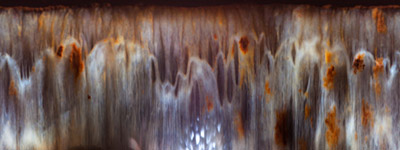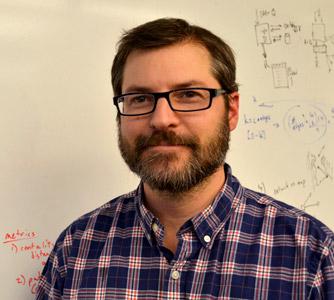Neil Abernethy's research team is developing new software called Outbreak Investigator. "It's a new tool for epidemiologists," he says. "It was set up to follow outbreaks of TB, but it could be used for SARS or pandemic influenza. It could also be used to see how Ebola spreads."
What is 'Outbreak Investigator' and why is it needed?
It's a data-driven, real-time tool that allows epidemiologists to ask simple questions such as, "Is this case connected to other cases I've seen? Is there a site of exposure that has not been investigated?" These are very straightforward questions that we can't ask with most databases.
Neil Abernethy on how software could track Ebola
Why can't we ask those questions now?
The public health infrastructure is fragmented. People with different backgrounds handle different pieces of the investigation. The lab owns the genotype data (the strain of disease), the investigator owns the social data (who was in contact with whom), and the physician owns the clinical data. Often this information is kept in separate tables or databases and sometimes in separate organizations and across state lines. We need ways to bring that information together to be able to recognize the broader trends responsible for an outbreak.
Can you give us an example of how your software would work?
It would help automate the process by showing a map of social connections between people who have a disease. You could see clusters and who had been in contact with whom. With better information, we could make decisions on where to allocate resources, where to distribute vaccines, how much money to spend per case, and when to expand a contact investigation.
When do you hope to see Outbreak Investigator in action?
HIGHLIGHTS
- Associate Professor, Biomedical Informatics and Medical Education
- PhD, Biomedical Informatics, Stanford University
- Postdoctoral researcher, UCSF
- Statistician, Medical Research Council, The Gambia
- BS, Applied Math, Biochemistry, North Carolina State University, 1993
We are developing the current version of the tool using the communicable disease database of Public Health – Seattle and King County, so even today it is designed to work with that system. In the coming year, we'll be piloting the tool and evaluating it. Jeff Duchin and Atar Baer (SPH faculty) from Public Health are co-investigators. The National Library of Medicine is funding us through a three-year grant.
What diseases are you tracking?
We started out developing it for TB, including micro-outbreaks of certain strains. But we've branched out with Public Health to include pertussis and potentially other diseases such as meningitis or hepatitis.
Could it have helped with the outbreak of Ebola?
In Nigeria, where there was a massive effort to coordinate contact information and visits, this kind of software could be useful in the event there is a suspected transmission chain, to help connect the dots between cases. And to help individual public health workers understand the big picture of the current outbreak, not just the cases they're responsible for.

Abernethy uses a prism to take photos
What does it take to develop this software?
A biostatistician, a software developer, a post-doctoral researcher and a research coordinator. We also have a few graduate students looking at epidemiological modeling, geography and a few other things.
How long have you been working on it?
This research theme began with my PhD dissertation in 2002. There have been a few iterations of it. I studied and developed it at Stanford, UCSF, the Francis J. Curry National Tuberculosis Center in San Francisco and here at the University of Washington.
What brought you to the UW?
It was a really unique opportunity to study public health informatics -- a burgeoning sub-discipline of biomedical informatics. We're focused on delivering analytical services and data standards and helping to conduct electronic surveillance for disease, capitalizing on increasingly electronic medical data and other sources. Some folks even use Twitter and other social media to inform these practices. We have a cluster of interested faculty across the UW. It's a really unique environment, with maybe only 10 schools that have a strong focus in this area.
"THE PUBLIC HEALTH INFRASTRUCTURE IS FRAGMENTED -- WE NEED TO BRING THAT INFORMATION TOGETHER TO RECOGNIZE THE BROADER TRENDS RESPONSIBLE FOR AN OUTBREAK"
Tell us about your other projects.
Working with McGill University, I have a grant from the Bill & Melinda Gates Foundation to integrate disease surveillance data – initially for malaria – that help us answer questions such as the proportion of laboratory-confirmed cases that received treatment in a population. We need to bring these sources together to recognize trends and target interventions more sensitively.
We also have a small grant from the Center of Excellence for Emerging Zoonotic and Animal Diseases at Kansas State University, funded by the Department of Homeland Security. Our subcontract is to develop a platform to enable comparison of epidemic models from different providers. Finally, I'm co-investigator of a grant from the Departments of Microbiology and Anthropology on HIV modeling. I collaborate with researchers from several other departments, including Global Health, Epidemiology, Sociology, Anthropology, Biostatistics, Genome Sciences, Computer Science and the Information School.

Polar transformation of an iris of the eye
Do you have time for any hobbies?
A few. I've been taking up a kind of artistic photography. It's my new way to blow off steam. I do macro-photography of the iris of the eye and blow it up so it looks like a painting. I also shoot through a refractive prism that separates out the colors of your subject. You get very pretty splotches of painted background. You might not know exactly what you're looking at, but you see rainbows and different colors. That's my fun project this year.
I have a guitar, a mandolin, a grand piano, a clarinet, a saxophone, a traditional wooden and goatskin drum, and many others. I enjoy discovering how to play things. If I had room, I would have a museum full of instruments.
Is there a connection between math and music?
There was for me. In mathematical sequences, in DNA sequences, and in computational information, there are patterns, and I enjoy studying and investigating them. I will say that if you convert DNA sequences to music, it sounds awful!
(By Jeff Hodson)
Originally Published: December 2014

